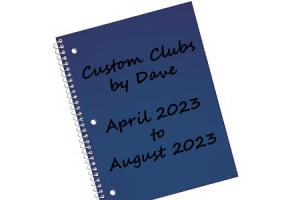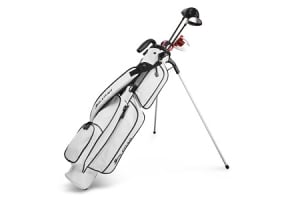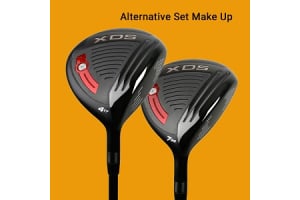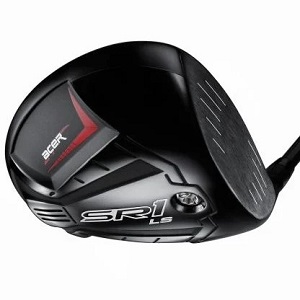
Back in August, we introduced you to the new Acer SR1 driver series. In the announcement, we said there would be more models as part of the family. We are excited to say one of those new additions will be the Acer SR1 LS driver. The LS happens to be short for “Low Spin” and I am here to explain why you might want to consider adding this driver into your bag.
A low spin driver is really a reduced spin driver
To understand this statement, we must first know the spin is created whenever a golf ball contacts a lofted club face. The more lofted the face; the more spin is created. Most people would know this as back spin, but it also applies to the angular tilt or side spin. In addition, the higher the club head speed is, the more back spin with all else being equal.
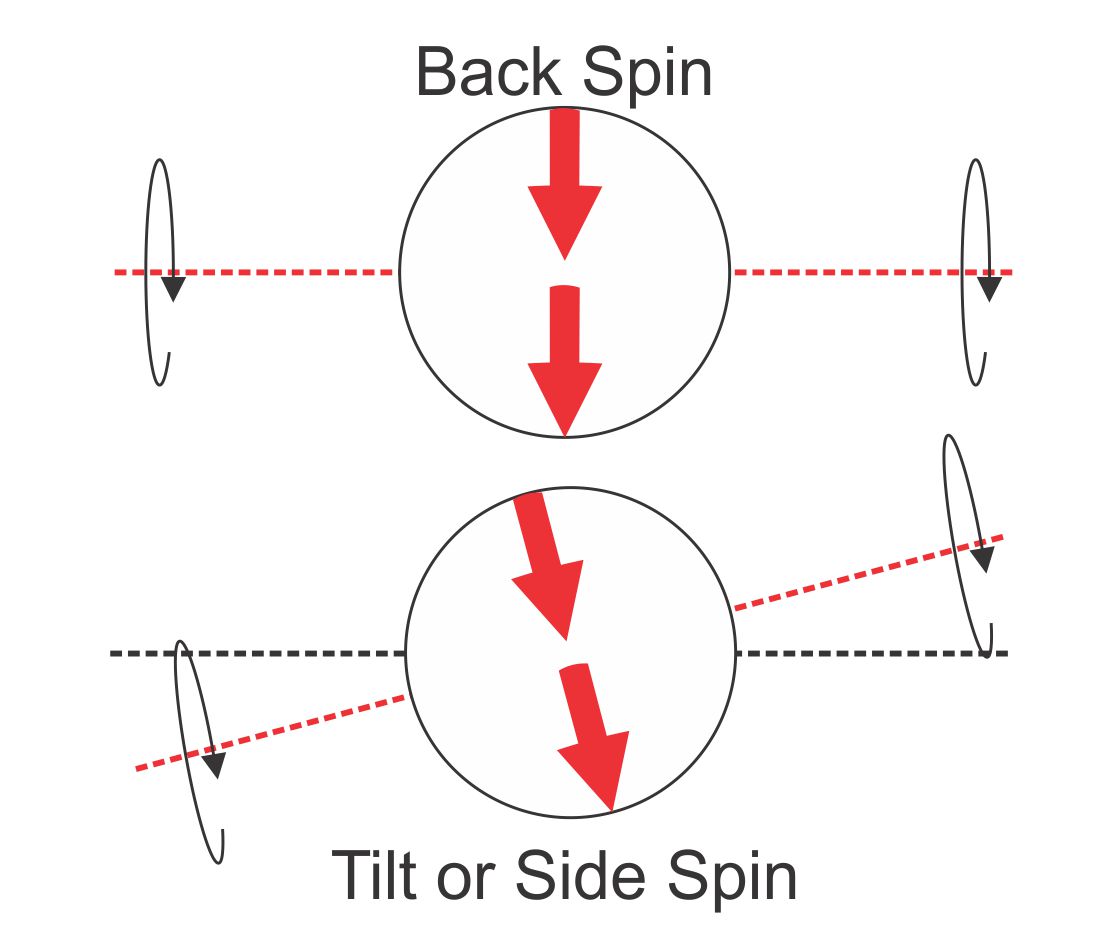
Neutral Axis and Center of Percussion
Next, let us look at some additional terms you may not be familiar with. One is called the neutral axis, which is a line perpendicular to the geographic center of the face. This is the part of the face you generally aim at but may not always be the optimal spot. In this illustration you will notice that the center of gravity icon of the clubhead is above the neutral axis. This is very common with a driver. The Acer SR1 LS model happens to have its’ center of gravity on the neutral axis line.
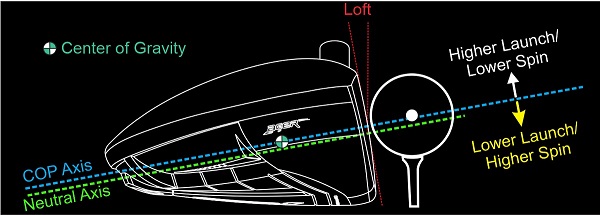
The next term is the Center of Percussion (COP) axis which intersects the vertical center of gravity of the head and is perpendicular to the loft angle of the head. If the golf ball’s center of gravity makes contact on the COP axis, then this will result in the least amount of rotation. This is often referred to as the “sweet spot” where the contact feels best, and the ball seems to spring off the face with its greatest speed.
What happens when you hit high or low on the club face?
Any impact higher than the COP axis will result in a higher launch angle, but it will also cause the amount of spin to be reduced. Why? This is due to the vertical gear effect. The head will rotate counterclockwise around its’ center of gravity (as shown) so this will impart a top spin to the ball. Technically it is not top spin because the spin produced by the loft is much greater, but the top spin is added to the back spin to essentially produce reduced back spin.

Any impact lower than the COP axis will result in a lower launch angle and an increased amount of spin. This causes the clubhead to rotate in a clockwise motion around its’ center of gravity (as shown). The vertical gear effect imparts an opposite spin (back spin in this case) to the ball, which is added on top of the back spin provided by the dynamic loft at impact.

The further the impact is higher up or lower on the face will additionally decrease or increase respectively the spin component by as much as +/- 1000 rpm. As we mentioned, a “Low Spin” driver is one that will have reduced back spin. How much spin reduction are you looking at realistically? With an identical club with the same loft and the only thing that has changed is the center of gravity location, the driver with the reduced spin is @ 200-300 rpm lower when the ball is struck in the same position. It doesn’t sound like a lot, but the difference matters.

Just like being fit for the correct loft driver or the proper flex shaft, the clubhead center of gravity is another fitting parameter. To know if you have too much or too little spin, you can seek a club fitter equipped with a quality launch monitor. If you have too little spin, you won’t carry the ball sufficiently and end up much shorter than your potential. If there is excessive spin, this will cause the ball to balloon and have the ball descending at a steep landing angle resulting in little roll.
In addition, your angle of attack or how the club head is delivered to the ball affects the dynamic loft. Chances are if you do not adjust the tee height, those that hit down on the ball (negative angle of attack), you might hit slightly higher on the face. Conversely, those that increase their dynamic loft at impact may contact the ball slightly lower on the face.
|
Impact Position |
Angle of Attack |
||
|
Negative |
Level |
Positive |
|
|
High |
Low Launch / Low Spin |
Mid Launch / Low Spin |
High Launch / Low Spin |
|
Sweet Spot |
Low Launch / Mid Spin |
Mid Launch / Mid Spin |
High Launch / Mid Spin |
|
Low |
Low Launch / High Spin |
Mid Launch / High Spin |
High Launch / High Spin |
Rear and forward CG locations
If we can horizontally move the CG forward or back, it can shift the center of percussion axis. Even though CG locations are all the same dimension above the groundline, the forward CG effectively has a lower sweet spot. This is the reason the further back you place the CG, the harder it is to maintain a golf club with a true low center of gravity or one that approaches the neutral axis. So, look at you ball marks on your driver to make sure they are at a minimum of the center of the face if not slightly higher.
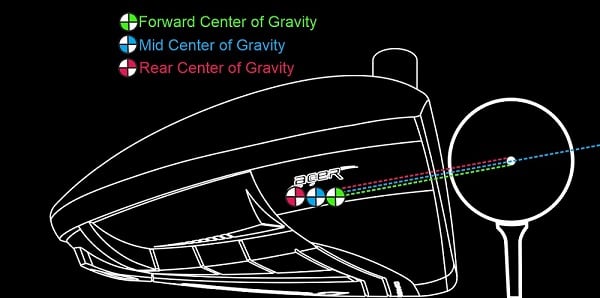
What type of golfer can benefit from a low spin driver?
First and foremost, we want to state there is no single center of gravity location that is ideal for every golfer. This is the reason manufacturers provide different weighted versions of a certain model head or they elect to have a model where the weight can be moved around. A low spin driver is another fitting option in which to choose from just like selecting the proper tee length or how far you insert the tee into the ground.
Low spin drivers were introduced to the market to provide an option for those golfers with higher swing speeds who were seeking to boost their ball speed and distance. However, a club head with a forward center of gravity location can benefit any golfer who desires a lower spin rate of the ball coming off the club face. Part of the reason is the shaft will not bow as far forward at impact producing a slightly lower launch angle and increased roll out for greater overall distance.
Is a low spin driver less forgiving?
While a driver with a forward center of gravity (or lower spin) may not create as much forgiveness on off-center shots as the same head with a rear center of gravity, the modern drivers are still very forgiving on miss-hits. However, for those golfers with reduced speed, spin can be crucial creating the carry distance they will need.
The Acer SR1 LS increases ball speeds across the entire face
Acer added a technologically enhanced active cup-face design to the forged, 4-piece construction to expand the sweet spot. What is this important? Titanium drivers are hollow shells and constructed from as little as two pieces to as many as six. Usually, a very thin flat sheet of titanium alloy is used for the face plate which is then welded to the crown, hosel and sole plate of the head around the perimeter of the face. This weld becomes thicker or more rigid than the areas around it, so the outermost regions of the face do not deflect nearly as much. Therefore, the highest performance area of the face is located at its' center of gravity.

In cup-face construction, part of the faceplate is incorporated into the sole, crown, and skirt area of the head. This pushes the weld back away from the actual face. Thus, the areas around the perimeter could be made thinner and have more deflection producing higher ball speeds to areas over a much wider area than the center of the face as compared to traditional edge-welded designs. Even when you miss-hit the ball, which we all do, clubs with active cup-face technology provide you with that extra spring-like effect for longer drives.
Is This the Best Acer Driver Ever Created?
As we have shown, the Acer SR1 LS possesses a forward center of gravity to provide reduced spin for those that need it, especially for golfers with higher swing speeds. For those that need the additional spin, don’t worry, you have the standard Acer SR1 to choose from.
In addition, the forward positioned Gravity Port allows for fine-tuning of swingweight for different shaft weights and balance points and custom assembly lengths. The stock screw is 7 grams and requires a 4mm Allen wrench if you want to substitute either the 2-gram aluminum screw or 12-gram tungsten screw (which are sold separately).
The SR1 LS driver has a somewhat muted sound at impact which is in the wheelhouse of what customers accept; a driver that is not too loud, yet not dead sounding either.
 |
| Purchase the Acer SR1 LS (Low Spin) Driver - Clubhead only |
| Purchase the Acer SR1 LS (Low Spin) Driver - Custom Assembled |


